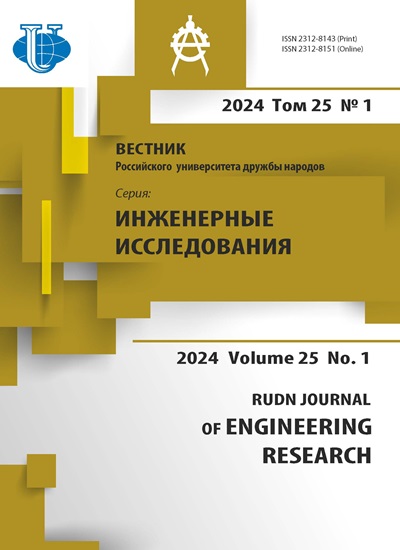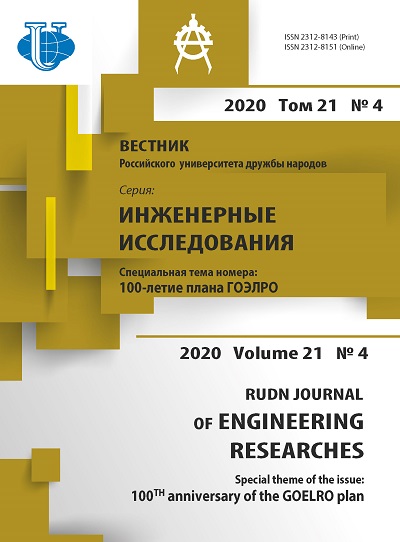Efficiency of using inverter power plants as part of multifunctional energy technology complexes
- Authors: Redko I.Y.1, Malozemov A.A.2, Malozemov G.A.2, Naumov A.V.2, Kozminykh D.V.2
-
Affiliations:
- G.M. Khrzhizhanovsky Power Engineering Institute
- South Ural State University (National Research University)
- Issue: Vol 21, No 4 (2020): 100th anniversary of the GOELRO plan
- Pages: 244-253
- Section: Articles
- URL: https://journals.rudn.ru/engineering-researches/article/view/26730
- DOI: https://doi.org/10.22363/2312-8143-2020-21-4-244-253
Cite item
Full Text
Abstract
A method has been developed for a comprehensive multi-criteria assessment of the efficiency of using inverter power plants as part of multifunctional energy-technological complexes with technical solutions aimed at reducing the negative consequences of the internal combustion engine operation with an optimal from the point of view of fuel efficiency speed. The method includes: synthesis of the optimal engine speed control algorithm, determination of the complex operating modes under operating conditions, assessment of changes in fuel consumption and harmful substances emissions with exhaust gases and resource consumption rate when the engine is switched to the operating mode with the optimal speed, complex technical and economic assessment of the inverter power plants efficiency. On the example of an inverter power plant with a capacity of 100 kW, the need to apply the method is proved. It was found that the engine operation with the optimal from the point of view of fuel efficiency speed and without additional design measures entails an increase in the damage accumulation rate by 1.7-2.1 times and therefore is economically inexpedient, despite a decrease in fuel consumption by 1% or more. It was found that a decrease in the compression ratio with a simultaneous increase in the boost pressure makes it possible to increase the engine resource up to a functional failure due to damage accumulation by 43% and to a parametric failure due to wear by 32%, while the operating costs of the inverter power plant will decrease by 3.7% relative to the base (no changes) power plants. The emission of soot particles will decrease by about 2 times, nitrogen oxides - by 2%, hydrocarbons - almost to zero.
About the authors
Ivan Ya. Redko
G.M. Khrzhizhanovsky Power Engineering Institute
Author for correspondence.
Email: redko_iya@mail.ru
Deputy General Director of JSC “ENIN”, Doctor of Technical Sciences, Professor
19 Leninskii Ave, Moscow, 119071, Russian FederationAndrey A. Malozemov
South Ural State University (National Research University)
Email: redko_iya@mail.ru
SPIN-code: 6622-7711
Professor of the Wheeled and Tracked Vehicles Department of the SUSU (NRU), Doctor of Technical Sciences, Associate Professor
76 Lenina Ave, Chelyabinsk, 454080, Russian FederationGeorgiy A. Malozemov
South Ural State University (National Research University)
Email: redko_iya@mail.ru
student of the Mathematics, Mechanics and Computer Technologies Faculty of SUSU (NRU)
76 Lenina Ave, Chelyabinsk, 454080, Russian FederationAlexey V. Naumov
South Ural State University (National Research University)
Email: redko_iya@mail.ru
Head of the Educational Unit, Deputy Head of the Tank Troops Department of the SUSU (NRU).
76 Lenina Ave, Chelyabinsk, 454080, Russian FederationDmitry V. Kozminykh
South Ural State University (National Research University)
Email: redko_iya@mail.ru
applicant of the Department of Wheeled and Tracked Vehicles of the SUSU (NRU).
76 Lenina Ave, Chelyabinsk, 454080, Russian FederationReferences
- Ministry of Energy of the Russian Federation. Energy Strategy of Russia for the period up to 2035. (In Russ.) Available from: https://minenergo.gov.ru/node/1026 (accessed: 14.12.2020).
- Bushuev VV, Voropay NI, Senderov SM, Saenko VV. About the energy security doctrine of Russia. Economy of Region. 2012;2(30):40–50. http://dx.doi.org/ 10.17059/2012-2-3.
- Malozemov AA, Kukis VS, Naumov AV. Hybrid power system with variable speed diesel engine. 2018 International Ural Conference on Green Energy (UralCon). Chelyabinsk; 2018. p. 63–68. http://dx.doi.org/10.1109/ URALCON.2018.8544335.
- Leuchter J, Bauer P, Kurka O. Configuration for mobile electrical power source. The International Conference on Power Electronics, Intelligent Motion and Power Quality (PCIM EUROPE 2004). 2004;(1):916–919.
- Manwell JF, Stein WA, Rogers A, McGowan JG. An investigation of variable speed operation of diesel generators in hybrid energy systems. Renewable Energy. 1992;(6):563–571. http://dx.doi.org/10.1016/0960-1481(92) 90019-Y.
- Lee JH, Lee SH, Sul SK. Variable-speed engine generator with supercapacitor: isolated power generation system and fuel efficiency. IEEE Transactions on Industry Applications. 2009;(6):2130–2135.
- Obukhov SG, Plotnikov IA. Experimental studies of a diesel generator set at variable speed. Bulletin of the Tomsk Polytechnic University. 2015;326:95–102.
- Khvatov OS, Samoyavchev IS, Darienkov AB. Simulation model of a unified ship power plant based on the system “internal combustion engine – generator” of variable rotation speed. Vestnik IGAU. 2012;(2):1–5.
- Malozemov AA, Shikin AS. Experiment-calculated estimation of derating level influence upon resource of converted B-2 type diesel engine. Bulletin of the South Ural State University. Series: Mechanical Engineering Industry. 2009;(24):89–96.
- Malozemov AA, Dooun VI, Kozminykh DV. Theoretical and experimental evaluation of diesel engine derating effect on its life time. Proceedings of the 5th International Conference on Industrial Engineering (ICIE 2019). Springer Nature Switzerland AG; 2020. р. 55–63. http://dx.doi.org/10.1007/978-3-030-22041-9_7.
- Kudryash AP. Nadezhnost i rabochiy protsess transportnogo dizelya [Reliability and working process of transport diesel engine]. Kiev: Naukova Dumka Publ.; 1981.
- Sreenath AK, Venkatesh S. Experimental studies on the wear of engine components. Wear. 1970;(16): 245–254. http://dx.doi.org/10.1016/0043-1648(70)90248-6.
- Malozemov AA, Bondar VN, Egorov VV, Malozemov GA. Digital twins technology for internal combustion engines development. Global Smart Industry Conference 2018. Chelyabinsk: IEEE Xplore Digital Library; 2018.
- Aleshkov OA, Malozemov AA. Povysheniye toplivnoy ekonomichnosti mnogofunktsional'nogo energotekhnologicheskogo kompleksa optimizatsiyey skorostnogo rezhima pervichnogo dizel'nogo dvigatelya v yego sostave [Improving the fuel efficiency of a multifunctional energy technology complex by optimizing the speed mode of the primary diesel engine in its composition]. Polzunovskiy Vestnik. 2009;(1/2):199–209.
- Orlov IN, et al. (eds.) Elektrotekhnicheskiy spravochnik. T. 3. Proizvodstvo i raspredeleniye elektricheskoy energii [Electrotechnical reference book. Vol. 3. Production and distribution of electrical energy]. Moscow: Energoatomizdat Publ.; 1988.
















